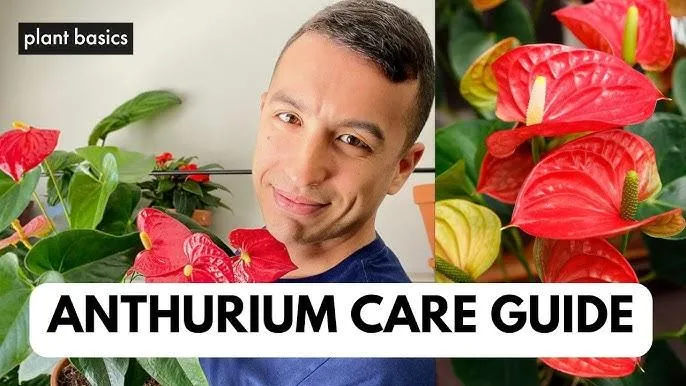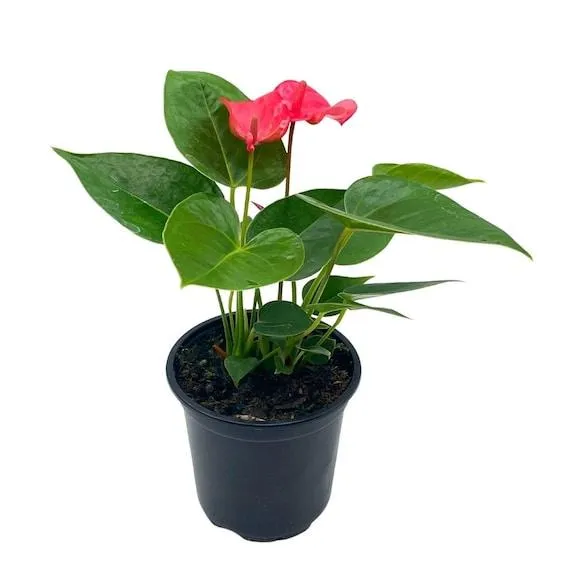Your Complete Guide to Growing Anthurium Gloriosum
The anthurium gloriosum, also known as the glorious anthurium, is a stunning tropical plant native to South America. With its heart-shaped leaves and bright red spathes (flower-like structures), it’s no wonder this plant catches the eye. In this in-depth guide, I’ll cover everything you need to know about caring for an anthurium gloriosum and helping it thrive in your home.
An Overview of Anthurium gloriosum
Let’s start with the basics. Anthurium gloriosum is an epiphytic plant, meaning it grows on other plants rather than directly in soil. In nature, you’ll commonly find it clinging to tree trunks in tropical rainforests. Its leaves have a waxy coating which helps protect them from water loss. Underneath each leaf is a node where new leaves emerge.
The really show-stopping part of this plant is its spathes. Growing upright on slender stalks, the spathes start out bright red and can last for months. They eventually fade but new ones will take their place. The spathes hold tiny flowers inside but you’d need a magnifying glass to see them!
Light Requirements
Light is crucial for healthy anthurium growth. These plants love bright, indirect light. Direct sunlight, especially in the middle of the day, can scorch their leaves. South- or east-facing windows generally work best. Give your plant at least 6 hours of lighting per day.
If light levels are insufficient, the spathes and leaves will be sparse and pale in color. The spaces between leaves may also lengthen, a sign it’s searching desperately for more sun. Moving it closer to the window should remedy the problem.

Water and Humidity
As epiphytes, anthuriums don’t like to have soggy feet. Water when the top inch of soil feels dry. Too much moisture can cause root rot. Also mist the leaves occasionally, as they enjoy high humidity around 50-60%. Consider a pebble tray or humidifier.
In very dry indoor air, the leaves may crisp at the edges. Boosting humidity prevents this. From my experience, crispy edges usually mean the plant needs more moisture in the air. A good misting usually does the trick.
Soil and Fertilizer
Pot your anthurium in a well-draining soil mix. I find adding extra perlite or bark helps ensure good drainage. Keep the soil lightly moist, not soggy. Place the plant in an inner pot with drainage holes and set it in a decorative outer pot.
Feed monthly in the spring and summer with a diluted liquid fertilizer for epiphytic plants. Too much fertilizer can burn the roots. In fall and winter, cut back to every other month as the plant is less actively growing.
Temperature and Propagation
Anthuriums prefer temperatures between 65-80°F. They’ll sulk below 60°F. In summer, move the plant out of direct sun if it’s getting too hot. In winter, protect from drafts near windows or vents. Rotating the pot encourages even growth.

You can propagate anthuriums by dividing the corms (bulb-like underground stems) or by starting new plants from leaf cuttings. Both methods have around a 50% success rate. Make cuts just above a node with a clean, sharp knife.
Pruning and Pests
Deadhead spent spathes by cutting them off where they join the stem. This encourages new blooms. Remove any crispy or diseased leaves at the base. Prune off tall, leggy stems to encourage bushier growth.
Watch out for mealybugs, spider mites, and scale insects. Isolate the plant at the first signs and spritz with insecticidal soap. As a preventative, wipe down leaves monthly with a soft cloth.
Troubleshooting Common Issues
If leaves are yellowing, the roots may have rotted from overwatering. Unpot the plant and check the condition of the roots. Trim off any mushy sections and repot in fresh soil. The spathes are likely the showiest part of your plant, so a lack of blooms indicates it needs more light, fertilizer, or to be divided.
At the same time, overfertilizing can cause burned spots and leaf drop. Likewise, intense sunlight or dry indoor heat may cause leaf scorch along the edges. Moving the plant or adjusting care can remedy problems before they escalate.

In Summary…
With the right conditions – bright light, moderate water, high humidity – your glorious anthurium should reward you with vibrant leaves and long-lasting red spathes. Be sure not to overwater or keep it in low-light. Take cuttings to expand your collection! Let me know if you have any other questions.
Anthurium Gloriosum Care Table
| Light | Bright indirect light. Avoid direct sunlight which can burn leaves. |
|---|---|
| Temperature | Daytime 70-80°F, nighttime 60-70°F. Cooler in winter, around 60-70°F. |
| Water | Keep soil moist but not soggy. Water when top inch of soil is dry. Do not overwater. |
| Humidity | High humidity 50-60%. Mist leaves daily if air is dry. |
| Fertilizer | Feed weakly every 2 weeks during growing season. Use a balanced houseplant fertilizer diluted to 1/2 the strength. |
| Potting Mix | Well-draining, such as potting soil mixed with perlite or bark. Repot every 2 years in spring. |
| Pruning | Cut off spent flower spathes and trim leaves occasionally to shape. |
FAQ
-
What’s an anthurium gloriosum?
Basically, an anthurium gloriosum is a plant species native to Ecuador. It’s a type of flowering plant known for its amazing heart-shaped leaves and unusual pink flowers. The flowers are sort of shaped like a flamingo’s beak, if you think about it!
-
How do you care for an anthurium gloriosum?
You’ll need to water your anthurium weekly and keep the soil moist but not soaked. Provide bright, indirect sunlight each day but protect it from direct sunlight, which can damage the leaves. Also be sure to occasionally fertilize during the Spring and Summer months. It seems the best soil mix includes lots of peat moss or coconut coir to retain moisture. Does anyone have tips for keeping pesky pests away?
-
What kind of conditions do they need?
Anthuriums thrive in humid conditions around 65-75°F. You’ll want to mist the leaves regularly to keep the humidity high. Provide shade if placed in a window, as direct sun can scorch the leaves. Interestingly, they can even tolerate low-light conditions as long as the soil stays consistently moist. I wonder, is it true some varieties do better with drier soil in between waterings?
-
Do anthurium blossoms have a scent?
Surprisingly, while anthurium flowers look amazing, they don’t produce much of a fragrance. Some varieties have a slightly sweet smell up close, but the scents are pretty mild. At the same time, the colorful heart-shaped blooms make wonderful floral arrangements. Who knows, maybe future breeding can create a gloriosum with an incredible perfume!

-
How long do the flowers last?
On average, an individual anthurium gloriosum blossom may persist for 2-3 weeks. However, plants will often rebloom several times a year if cared for properly with ample water and nutrients. Quote the source, like Monrovia Nursery states the colorful spadix can last over a month! Unlike some plants, anthuriums won’t die after flowering either.
-
Are anthuriums poisonous?
Most varieties of anthurium are considered non-toxic to humans. However, it appears the sap contains calcium oxalate crystals that can cause a tingling, itchy sensation or slight irritation if touched and then rubbed in the eyes or inside the mouth. So you might want to wear gloves when repotting and wash hands afterwards, just to be safe. But is it worth it for such a gorgeous houseplant?
